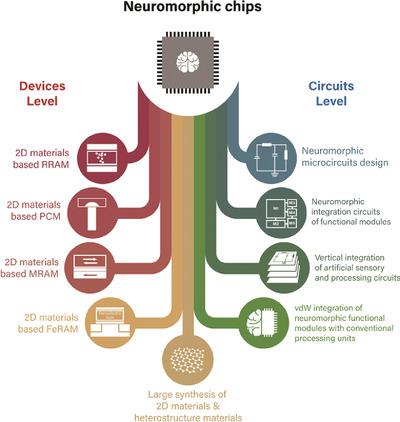当前位置:
X-MOL 学术
›
Adv. Electron. Mater.
›
论文详情
Our official English website, www.x-mol.net, welcomes your
feedback! (Note: you will need to create a separate account there.)
2D Layered Materials for Memristive and Neuromorphic Applications
Advanced Electronic Materials ( IF 5.3 ) Pub Date : 2019-12-11 , DOI: 10.1002/aelm.201901107 Chen‐Yu Wang 1 , Cong Wang 1 , Fanhao Meng 1 , Pengfei Wang 1 , Shuang Wang 1 , Shi‐Jun Liang 1 , Feng Miao 1
Advanced Electronic Materials ( IF 5.3 ) Pub Date : 2019-12-11 , DOI: 10.1002/aelm.201901107 Chen‐Yu Wang 1 , Cong Wang 1 , Fanhao Meng 1 , Pengfei Wang 1 , Shuang Wang 1 , Shi‐Jun Liang 1 , Feng Miao 1
Affiliation

|
With many fantastic properties, memristive devices are a top candidate for next‐generation memory and neuromorphic computing chips. Significant research progress has been made in improving the performance of individual memristive devices and in demonstrating functional applications based on small‐scale memristive crossbar arrays. However, practical deployment of large‐scale traditional metal‐oxide‐based memristive crossbar arrays has been challenging due to several issues, such as high power consumption, poor device reliability, and low integration density. To solve these issues, new materials that exhibit superior properties are required. 2D layered materials exhibit many unique physical properties and show great promise in solving these challenges, further providing new opportunities to implement practical applications in neuromorphic computing. Recent research progress in 2D layered‐material‐based memristive device applications is reviewed. An overview of the progress in and challenges for the use of 2D layered materials to solve the issues of conventional memristive devices and to realize more complex functionalities in neuromorphic computing is provided. Additionally, an outlook of exploitation of the unique properties of 2D layered materials and van der Waals heterostructures for developing new types of memristive devices and artificial neural microcircuits is given.
中文翻译:

忆阻和神经形态应用的2D分层材料
忆阻器件具有许多出色的性能,是下一代内存和神经形态计算芯片的最佳候选者。在改善单个忆阻器件的性能以及演示基于小型忆阻交叉开关阵列的功能应用方面,已经取得了重要的研究进展。但是,由于一些问题,例如高功耗,较差的设备可靠性和较低的集成度,实际部署大型传统的基于金属氧化物的忆阻交叉开关阵列一直具有挑战性。为了解决这些问题,需要表现出优异性能的新材料。2D层状材料展现出许多独特的物理特性,并在解决这些挑战方面显示出巨大的希望,进一步为在神经形态计算中实现实际应用提供了新的机会。综述了基于2D分层材料的忆阻设备应用的最新研究进展。提供了使用2D分层材料来解决常规忆阻设备问题并在神经形态计算中实现更复杂功能的进展和挑战的概述。此外,展望了开发二维层状材料和范德华异质结构以开发新型忆阻器件和人工神经微电路的独特前景。
更新日期:2020-02-13
中文翻译:

忆阻和神经形态应用的2D分层材料
忆阻器件具有许多出色的性能,是下一代内存和神经形态计算芯片的最佳候选者。在改善单个忆阻器件的性能以及演示基于小型忆阻交叉开关阵列的功能应用方面,已经取得了重要的研究进展。但是,由于一些问题,例如高功耗,较差的设备可靠性和较低的集成度,实际部署大型传统的基于金属氧化物的忆阻交叉开关阵列一直具有挑战性。为了解决这些问题,需要表现出优异性能的新材料。2D层状材料展现出许多独特的物理特性,并在解决这些挑战方面显示出巨大的希望,进一步为在神经形态计算中实现实际应用提供了新的机会。综述了基于2D分层材料的忆阻设备应用的最新研究进展。提供了使用2D分层材料来解决常规忆阻设备问题并在神经形态计算中实现更复杂功能的进展和挑战的概述。此外,展望了开发二维层状材料和范德华异质结构以开发新型忆阻器件和人工神经微电路的独特前景。











































 京公网安备 11010802027423号
京公网安备 11010802027423号